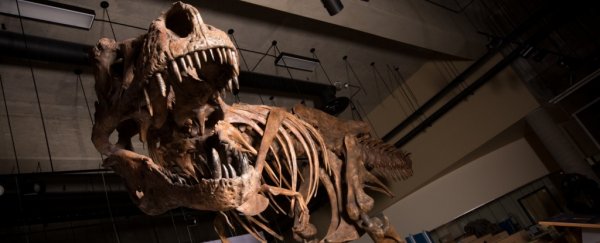We all knew the mighty Tyrannosaurus rex was big. But palaeontologists in Canada have just identified the biggest lizard tyrant king yet - its name is Scotty, and boy was it a corker.
From nose to tail-tip, Scotty measures 13 metres (43 feet), and would have cracked the scales at 8,800 kilograms (19,400 pounds), based on a calculation using its mighty thigh-bones.
"This is the rex of rexes," said palaeontologist Scott Persons of the University of Alberta in Canada.
"There is considerable size variability among Tyrannosaurus. Some individuals were lankier than others and some were more robust. Scotty exemplifies the robust. [It] comes out a bit heftier than other T. rex specimens."
The bones are not actually new. They were discovered in Saskatchewan in 1991, but since they were embedded in some pretty solid sandstone, the excavation was a slow and painstaking process, taking over a decade.
Then palaeontologists had to put the bones back together - another slow and painstaking process. But it was worth it, because now those bones are finally giving up their secrets.
For instance, we know that Scotty (named for the bottle of Scotch whisky opened to celebrate the skeleton's initial discovery) was exceptionally old - it has lived longer than any other T. rex discovered to date.
Palaeontologists can figure this out by looking at a dinosaur's bones. Annual variations in climate and food availability would slow dinosaurs' bone growth, which results in a ring. These rings - much like the rings of a tree trunk - can be counted to estimate a dinosaur's age of death.
It was thought that T. rex had a lifespan of around 30 years; the previous oldest ever found, Trix, had an estimated age of about 30.
Scotty had a year or two on Trix - it died in its early 30s. "By Tyrannosaurus standards," Persons said, "it had an unusually long life."
Scotty's bones also had extensive injuries that showed signs of healing. Which means the old animal who lived 66 million years ago in the Cretaceous, got into a lot of scrapes - and somehow survived them.
The injuries include broken ribs, an infection in the dino's jaw, and marks on its tail that could be from a bite inflicted by another T. rex in an epic battle.
It may come from somewhat teeny tiny origins, but there's a reason T. rex became one of the most beloved extinct animals to have ever trod Earth. As Scotty demonstrates, it was a formidable beast indeed.
"I think there will always be bigger discoveries to be made," said Persons. "But as of right now, this particular Tyrannosaurus is the largest terrestrial predator known to science."
The research has been published in The Anatomical Record.
